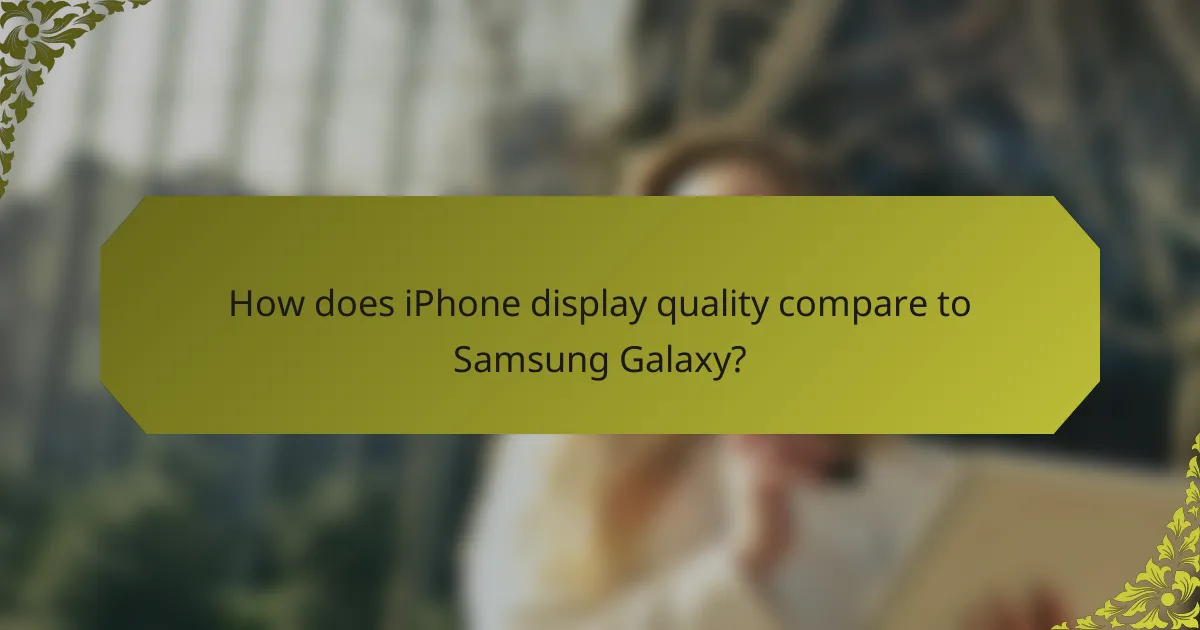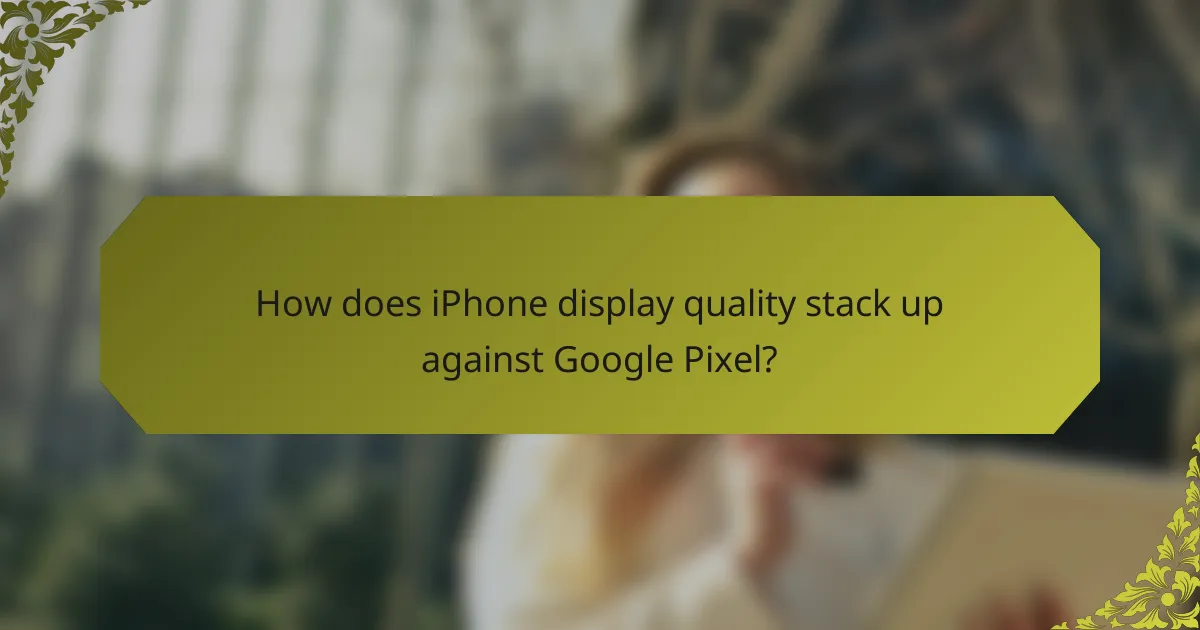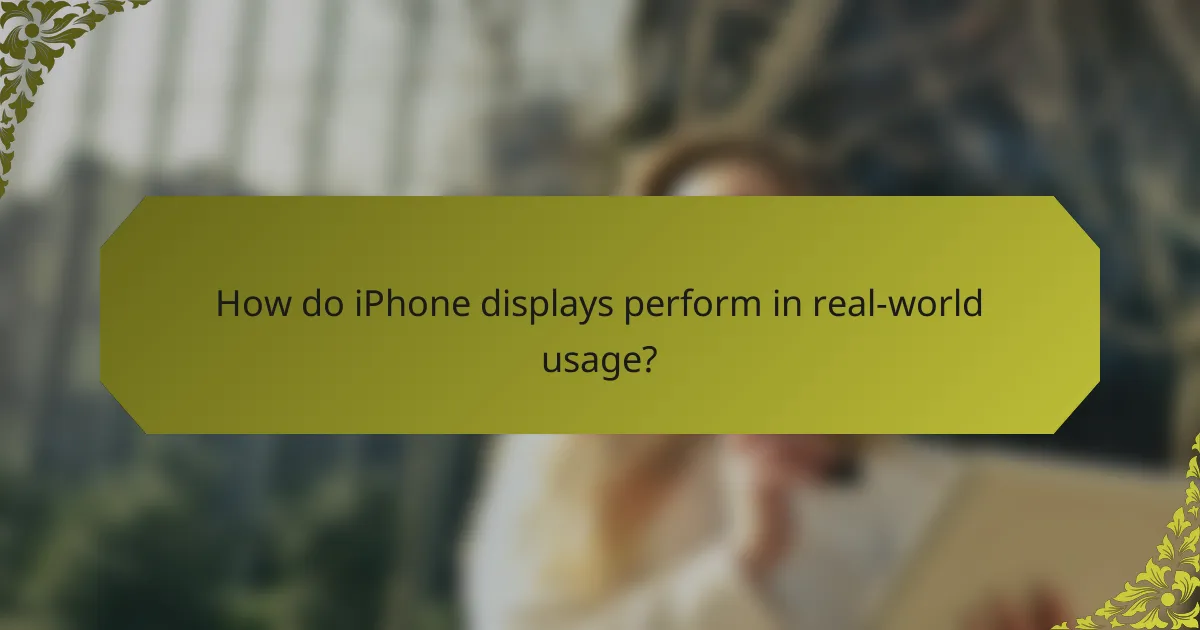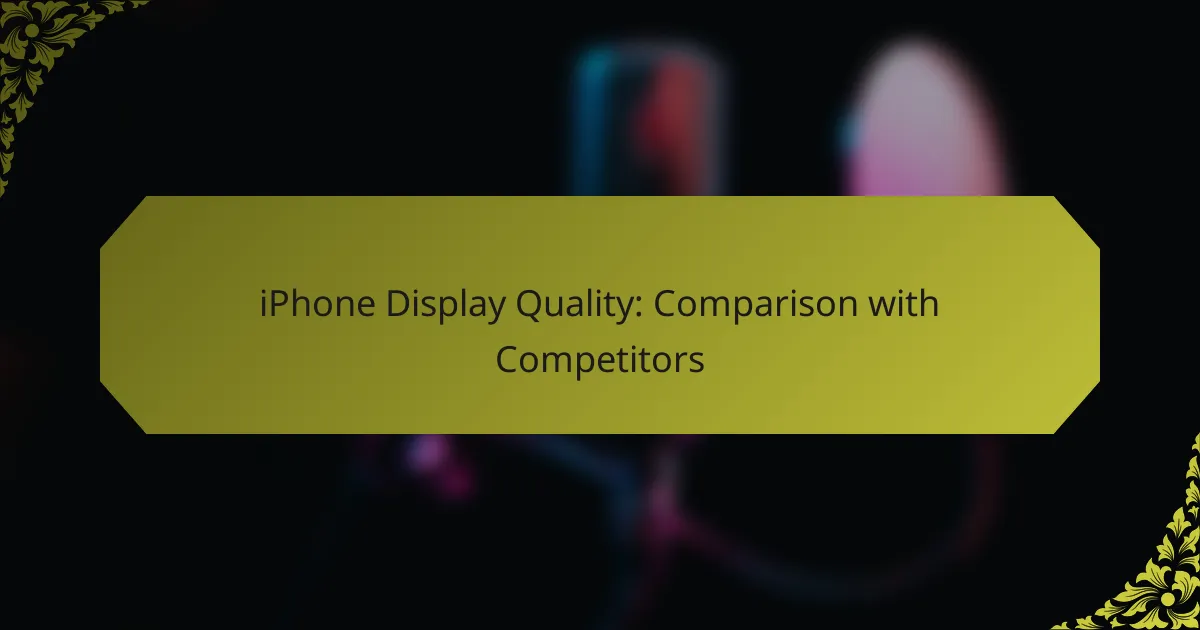The iPhone display quality is widely recognized for its excellence, often outperforming competitors like Samsung Galaxy and Google Pixel in key areas such as color accuracy, brightness, and overall clarity. With advanced technologies like Retina display, True Tone, and ProMotion, iPhones provide a premium viewing experience that appeals to users seeking the best in mobile screen performance.

How does iPhone display quality compare to Samsung Galaxy?
The iPhone display quality is often regarded as superior to that of Samsung Galaxy devices, particularly in terms of color accuracy, peak brightness, and HDR performance. These factors contribute significantly to the overall viewing experience, making the iPhone a preferred choice for many users.
Superior color accuracy
The iPhone is known for its exceptional color accuracy, which is crucial for tasks like photo editing and graphic design. Apple employs advanced calibration techniques to ensure that colors are represented as closely to real life as possible.
In contrast, Samsung displays may sometimes exaggerate colors for a more vibrant look, which can be appealing for casual viewing but less ideal for professional use. Users who prioritize true-to-life colors may find the iPhone’s display more suitable for their needs.
Higher peak brightness
iPhones typically achieve higher peak brightness levels compared to Samsung Galaxy devices, enhancing visibility in bright environments. This feature is particularly beneficial for outdoor usage, where sunlight can wash out screens.
For instance, iPhones can reach peak brightness levels of around 800 nits or more, while many Samsung models hover around similar figures but may not consistently match the iPhone’s performance in all conditions. This difference can impact the usability of the device in various lighting scenarios.
Better HDR performance
The iPhone excels in HDR (High Dynamic Range) performance, delivering a more dynamic range of colors and contrast. This capability allows for richer visuals when viewing HDR content, making it a strong choice for streaming movies and playing games.
Samsung Galaxy devices also support HDR, but the iPhone’s implementation often results in better detail retention in both highlights and shadows. Users looking for an immersive viewing experience with HDR content may prefer the iPhone for its superior performance in this area.

What are the key features of iPhone displays?
iPhone displays are known for their advanced technology, which includes high resolution, color accuracy, and smooth performance. Key features such as Retina display technology, True Tone color adjustment, and ProMotion refresh rate contribute to an exceptional viewing experience.
Retina display technology
Retina display technology refers to Apple’s high-resolution screens that provide sharp and clear visuals. The pixel density is so high that individual pixels are virtually indistinguishable from the human eye at a normal viewing distance, enhancing text readability and image clarity.
This technology typically features resolutions that exceed 300 pixels per inch (PPI), making it ideal for tasks like photo editing and gaming. Users can expect vibrant colors and deep contrasts, which are crucial for an immersive experience.
True Tone color adjustment
True Tone color adjustment is a feature that automatically adjusts the display’s white balance based on the ambient lighting conditions. This ensures that colors appear consistent and natural, whether indoors or outdoors.
By using advanced sensors, True Tone enhances the viewing experience by reducing eye strain and improving color accuracy. This feature is particularly beneficial for tasks like graphic design or reading, where accurate color representation is essential.
ProMotion refresh rate
ProMotion refresh rate technology allows iPhone displays to support refresh rates of up to 120Hz, resulting in smoother scrolling and more responsive touch interactions. This is particularly noticeable during gaming or when browsing through content-heavy applications.
The adaptive refresh rate can vary based on the activity, which helps conserve battery life while still providing a fluid experience. Users should consider this feature if they prioritize performance and responsiveness in their device.

How does iPhone display quality stack up against Google Pixel?
The iPhone display quality generally surpasses that of Google Pixel devices, particularly in areas such as sharpness, color vibrancy, and outdoor visibility. Apple’s consistent focus on display technology has resulted in screens that offer a premium viewing experience compared to their competitors.
Enhanced sharpness and clarity
iPhone displays are known for their high pixel density, which contributes to enhanced sharpness and clarity. The Retina display technology used in iPhones typically features resolutions that exceed 300 pixels per inch (PPI), making text and images appear exceptionally crisp.
In contrast, Google Pixel devices, while also offering high-resolution displays, often fall slightly short in pixel density, especially in older models. This difference can be noticeable when viewing fine details or reading small text.
More vibrant color reproduction
The color reproduction on iPhone displays is often more vibrant and accurate, thanks to Apple’s calibration processes and the use of high-quality OLED panels in recent models. This results in richer colors and better contrast ratios, making images and videos more lifelike.
Google Pixel devices utilize OLED technology as well, but some users report that colors can appear less saturated compared to iPhones. This can affect the overall visual experience, particularly for media consumption.
Superior outdoor visibility
iPhones are designed with outdoor visibility in mind, featuring higher peak brightness levels that enhance screen readability in direct sunlight. Many recent iPhone models can reach peak brightness levels of around 800 to 1200 nits, making them easier to use outdoors.
While Google Pixel devices also offer good outdoor visibility, they typically do not match the peak brightness levels of iPhones. Users may find it more challenging to read the screen in bright conditions, which can be a significant factor for those who frequently use their phones outside.

What factors influence smartphone display quality?
Smartphone display quality is influenced by several key factors, including resolution, display technology, and color accuracy. Understanding these elements can help consumers make informed choices when comparing devices.
Resolution and pixel density
Resolution refers to the number of pixels displayed on the screen, typically measured in width by height (e.g., 1920×1080). Higher resolution generally leads to sharper images, while pixel density, measured in pixels per inch (PPI), indicates how densely packed the pixels are. A higher PPI means clearer visuals, especially noticeable when viewing content up close.
For most users, a resolution of at least 1080p (Full HD) is recommended for a satisfactory experience, while premium devices often feature 1440p (QHD) or even 2160p (4K) displays. However, higher resolutions can consume more battery power, so it’s essential to balance display quality with battery life.
Display technology (OLED vs LCD)
The two primary display technologies are OLED (Organic Light Emitting Diode) and LCD (Liquid Crystal Display). OLED displays offer better contrast, deeper blacks, and more vibrant colors since each pixel emits its own light. In contrast, LCDs rely on a backlight, which can lead to less impressive color reproduction and contrast.
When choosing between OLED and LCD, consider your usage patterns. OLED is ideal for media consumption and gaming due to its superior color and contrast, while LCD may be sufficient for basic tasks and can be more cost-effective. Additionally, OLED screens may be more prone to burn-in, which is a factor to consider for long-term use.
Color gamut and accuracy
Color gamut refers to the range of colors a display can reproduce, while color accuracy indicates how closely the displayed colors match real-world colors. A wider color gamut allows for more vibrant and varied colors, enhancing the viewing experience. Common standards for color gamut include sRGB, Adobe RGB, and DCI-P3.
For optimal color performance, look for displays that cover a significant percentage of the DCI-P3 color space, which is commonly used in film and video production. This ensures that the colors you see are true to life. Additionally, consider devices that offer color calibration features to maintain accuracy over time.

How do iPhone displays perform in real-world usage?
iPhone displays are known for their high quality, offering vibrant colors and sharp resolutions that enhance user experience. In real-world usage, they generally outperform many competitors in terms of clarity, durability, and efficiency.
Durability and scratch resistance
iPhone displays utilize durable glass, often featuring Ceramic Shield technology, which significantly improves scratch resistance compared to many other smartphones. This means that everyday objects like keys or coins are less likely to cause damage.
While no display is completely scratch-proof, iPhones typically withstand minor abrasions better than competitors. Users should still consider applying a screen protector for added security against drops and scratches.
Battery consumption efficiency
iPhone displays are designed to optimize battery consumption, especially with features like adaptive brightness and low power modes. These settings help extend battery life during regular usage, making iPhones efficient even with high-resolution displays.
In practical terms, users can expect their iPhone’s display to consume less power than many rival devices, particularly when displaying static content or using dark mode. This efficiency can lead to several hours of additional usage between charges.
Viewing angles and sunlight legibility
iPhone displays offer excellent viewing angles, allowing users to see content clearly from various positions without significant color distortion. This is particularly beneficial for sharing screens with others or when using the device in different orientations.
Sunlight legibility is another strong point for iPhone displays, with high brightness levels that make it easier to read in bright outdoor conditions. Users should take advantage of the maximum brightness setting when outdoors to enhance visibility.

What are the emerging trends in smartphone display technology?
Emerging trends in smartphone display technology focus on enhancing resolution, refresh rates, and energy efficiency. Innovations such as OLED and mini-LED displays are becoming more common, providing vibrant colors and deeper blacks, while adaptive refresh rates improve user experience during gaming and scrolling.
Higher Refresh Rates
Higher refresh rates, typically ranging from 90Hz to 120Hz, are becoming standard in many flagship smartphones. This feature allows for smoother animations and improved responsiveness, particularly in gaming and scrolling through content. Users should consider devices with at least a 90Hz refresh rate for a noticeably better experience.
Increased Brightness and HDR Support
Smartphone displays are now achieving higher brightness levels, often exceeding 1000 nits, which enhances visibility in bright environments. High Dynamic Range (HDR) support is also becoming prevalent, allowing for a wider range of colors and improved contrast. Users should look for HDR10 or Dolby Vision support for optimal viewing experiences.
Flexible and Foldable Displays
Flexible and foldable displays are revolutionizing smartphone design, enabling larger screens in compact devices. These displays can bend and fold without compromising quality, offering unique form factors. However, potential buyers should be aware of durability concerns and the current limitations in app compatibility.
Energy Efficiency and Sustainability
Energy efficiency is a growing trend, with manufacturers focusing on reducing power consumption while maintaining display quality. Technologies like OLED consume less power when displaying darker images, contributing to longer battery life. Consumers should consider energy-efficient options, especially for devices used extensively throughout the day.
